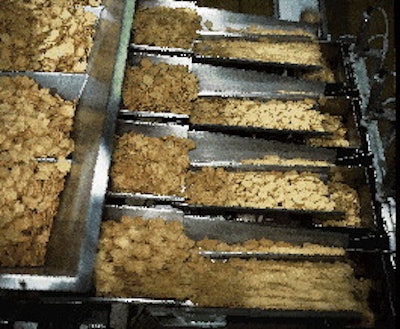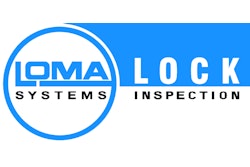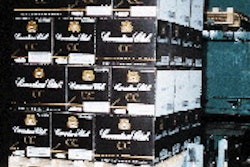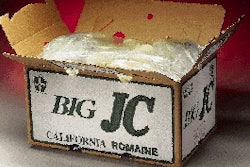What began as a simple conversion from gabletop cartons to paperboard canisters has expanded into a multi-product opportunity for Keebler Co. of Elmhurst, IL. "Things have happened virtually overnight," says Bruce Flowers, Keebler business development manager. The "things" Flowers refers to are newly developed paperboard canisters for seven products in three sizes. Manufactured by Sonoco (Hartsville, SC), the spiral-wound canisters are filled for Keebler by contract packager Production Packaging (St. Charles, IL). The canisters include two body plies of recycled paperboard and a layer of foil for barrier purposes. The first one rolled out by Keebler was for Animal Crackers marketed to club stores. Traditionally, Keebler had packaged these in a 2-lb gabletop carton. "We wanted to contemporize our animal cracker package to reflect Keebler quality," says Flowers. "We were looking at other types of packaging, such as plastic jugs, when Sonoco presented their canister with competitive pricing, resealability advantages and improved graphics capabilities." The label graphics come by way of gravure printing in up to six colors executed by Sonoco Flexible. The labels are applied to the canisters during the winding process. "Many times companies will shy away from gravure because of the cost, but we felt the superior reproduction it offered was critical because of the colorful, eye-catching graphics on our packages," says Flowers. "The fact that Sonoco could deliver the printing capabilities we wanted, at a price far lower than we expected, was a welcome surprise." Other features Flowers likes are Sonoco's Sealed-Safe® membrane inner seal and a resealable polypropylene overcap supplied by Tech II (Springfield, OH). "We're really marketing this new package to the family," says Flowers. "Our club store market for products in these packages is typically day care centers, but we think families will see the multiple benefits of this canister, particularly the opening and reclosure system." Animal Crackers led the way Keebler launched its 603 x 908 2-lb club store canister of Animal Crackers in August of '97. Consumer response was excellent, so the firm followed with 2-lb Pecan Sandies® in a 603 x 800 in September, Nacho Cheez-it®s in a 603 x 908 in November, and Vanilla Wafers in a 603 x 908 in March of this year. Flowers didn't stop with club store sizes, either. Eyeing drug and convenience stores, he worked with Sonoco to develop a 211 x 800 canister holding just 5 oz of either Pecan Sandies, Chips Deluxe®, Rainbow Chips Deluxe® or Cheez-its. (The three cookies are all "snack size" as opposed to full size.) These packs all debuted in national drug store chains in February of this year. "Everything about our new packages says to the consumer 'pick me up, try me,'" says Flowers. "While researching the major drug chains, we noticed there weren't many options in the cookie section. Most cookies are sold in either bulky, non-recloseable grocery packages or in single-serve packs. On the other hand, there were lots of salty snacks in canisters. We saw an opportunity to marry our product to a proven package." The tall, sleek 211 canister created for the drug store market is especially well-suited for today's consumers and their hectic lifestyles, says Flowers. It fits neatly into a purse or briefcase, or it can be stashed in a car's cup holder or glove box for a snack on the go. Keebler's new canisters offer another advantage over bagged, boxed or gabletop packs for cookies and crackers: ease of handling. Rugged in construction, the canisters withstand the rigors of distribution with minimal protective packaging. As Production Packaging vice president Gary Cremieux puts it: "You don't have to add all kinds of corrugated dividers like you do with, say, a gabletop carton." Location, location, location Production Packaging was selected by Keebler as contract packager partly on the strength of its central midwest location. It didn't hurt, either, that before joining Production Packaging, Cremieux had spent 11 years at Keebler and knew the kind of packaging operations the firm would be comfortable with. "We installed an automated line and had it up and running in eight weeks," says Cremieux. "Because of the economical design of the package and the type of product, we kept the production very simple and efficient. Sonoco also provided a lot of technical support in setting up the line." Central to the line today is the four-bucket filler, Model PMB-4, from Weigh Right Automatic Scale (Joliet, IL). But that's not the machine used by Production Packaging in the earliest days of packaging for Keebler, says Cremieux. "Keebler wanted the canisters in a hurry, and there was no way we could purchase a new dump-filler that quickly. So Weigh Right supplied us with a temporary rental unit that we adapted and got running just to get Keebler into the business." Keebler's product arrives at Production Packaging in 20-lb corrugated cases that are dumped into a floor-level hopper. Product drops by gravity onto a conveyor belt that runs through a metal detector supplied by Cintex (Kenosha, WI). Immediately following the Cintex unit, product drops a short distance into the buckets of a bucket elevator system from FMC (Green Bay, WI). This machine carries the cookies or crackers from floor level to a hopper mounted above the four-bucket dump filler. A diverter fans product out evenly across the Weigh Right system's four-compartment hopper. From the four hoppers, cookies tumble onto two sets of vibratory feed trays. The first provides a bulk feed, the second a dribble feed. Finally, product drops into the weigh buckets, each fitted with a strain gauge load cell. When the proper weight has been reached, the vibratory feed trays automatically shut down until the bucket has emptied its charge and is ready for another. Canister handling Canisters, which are manually depalletized, reach the filler on an infeed conveyor. Canister tops, which incorporate Sonoco's membrane opening, are already seamed on. The canisters are placed bottom-up on the infeed conveyor. Before they reach the filling station, they pass through a twist rail and deionizer air blow system that removes any dust and particulates. Exiting the air blow cabinet, canisters pass through twist rails that return them to their bottom-up orientation. A photocell detects when a canister has reached the filling station and signals an air-actuated stop mechanism to hold that canister in place. Meanwhile, the system's programmable logic controller constantly scans the condition of the four scales to see which one is ready to dump. If all four are ready, it signals the scales to dump in sequence from one to four. Once released, product is funneled down toward the waiting canister. A "diving spout" strokes into the canister with each product charge to ensure a clean transfer of cookies into the container. Current speeds are 30 two-lb canisters/min. Weigh Right also was responsible for the 10' conveyor section that takes canisters into and out of the filling area. It's a vibratory conveyor that enhances settling of the cookies. Exiting the filler, canisters are conveyed into an older but rebuilt rotary seamer. It embosses date and production code information on the canister end. The rest of the packaging operation-application of the PP overcap, palletizing and pallet wrapping-is done by hand. As Keebler scans the marketplace for new canister opportunities, the new line at Production Packaging stays busy. Flowers says current plans call for additional club store products in canisters in the future. "The Sonoco canister was such a great idea, we wondered why no one else in the cookie and cracker industry had thought of it," says Flowers. "Instead of waiting to find out, we jumped on it."



























